Planning March 2020
Are You Solar Ready?
Seven steps to successfully manage large-scale solar development.
By Megan Day, AICP
Communities across the U.S. are experiencing growing development pressures for large-scale solar — photovoltaic (PV) — systems of several to thousands of acres in size. This trend is driven by rapidly dropping prices coupled with increasing demand for clean energy. According to the Lawrence Berkeley National Laboratory, utility-scale PV costs dropped by 70 percent from 2010 to 2018 and are consistently about a third of the cost per watt of residential rooftop PV.
By 2050, large-scale PV deployment is projected to increase to roughly eight times the current installed capacity, according to mid-case standard scenario modeling by the National Renewable Energy Laboratory (NREL). That translates into solar development on approximately 2.6 million additional acres of land — more than three times the size of Rhode Island.
The growing demand for electricity from low-cost, large-scale PV will pose challenges as states and communities struggle to address this new form of land use and development. There may be fear and opposition to changing landscapes and land uses. Plans, zoning codes, and inspection processes may not contemplate this form of development, so they may require revisions.

At a University of Massachusetts test site in South Deerfield, a grad student and professor harvest Swiss chard growing under PV arrays. A National Renewable Energy Laboratory project is underway to study the compatibility and mutual benefits of solar development with agriculture and native landscapes. Photo by INSPIRE, NREL/DOE.
Large-scale solar development challenges ahead
Fortunately, communities willing to tackle these challenges can employ strategies that will not only help them be prepared when large-scale solar developers come to call, but also help them leverage emerging solar development opportunities to achieve myriad community benefits, including job creation, economic development, clean energy, and even agricultural production and habitat value.
1. Lay the Groundwork

Photo by Werner Slocum, NREL/DOE.
Integrating solar development into community goals and objectives and setting large-scale solar performance standards are the first steps to solar success. Addressing solar in planning processes and codes will enable a community to contemplate how and where large-scale PV development is desired. Strategies for solar-ready communities include:
Comprehensive plans that identify solar resources like other natural and extractable resources. Plans should set goals and address large-scale PV as an economic development opportunity in terms of land use and in utility and infrastructure planning.
Development regulations that explicitly address all forms of solar development (large-scale, accessory to a principal use of a property, rooftop versus ground-mounted or not attached to an existing structure). NREL research shows that communities that address solar in their codes have more installed solar per capita.
Permitting processes that are predictable, transparent, and documented.
Being solar ready also means integration and consistency among multiple plans and goals. For example, a 100-percent clean electricity goal has associated solar development land-use planning, zoning code, and comprehensive plan implications. Similarly, farmland or open space preservation plans can provide guidance on how PV development may be compatible with and further these goals (e.g., where PV can be colocated with farmland or provide predictable revenues to support farm preservation) and where PV development is incompatible (e.g., critical viewsheds or forested land). Solar-ready communities align solar development standards and targets in the comprehensive plan with land use, resilience, climate action, energy, and infrastructure planning.
2. Recognize Large-Scale PV as a Unique Land Use
While some planners may view large-scale PV as an industrial or utility land use, PV does not generate industrial or fossil fuel impacts like pollution, noise, and traffic.
Large-scale solar installations are quiet, emission-free facilities that generally have no on-site staff other than occasional maintenance workers.
Industrial land uses often require access to major transportation corridors and water, sewer, and natural gas utilities, none of which PV requires. Large-scale PV installations only require a connection with the local electrical transmission or distribution system.
Requiring land developed for solar to rezone to industrial or utilities designations can lead to isolated parcels where future development of heavy industry or a fossil fuel plant is unwanted.
Large, unencumbered, flat agricultural and rural lots near existing substations make attractive large-scale PV sites, though even urban residential areas are suitable if the demand exists and the regulations allow it.
Anticipatory rezoning and designating PV development locations may prove futile because locations with capacity on electrical lines, reasonable costs to interconnect, and market demand change over time.
3. Identify a Development Pathway
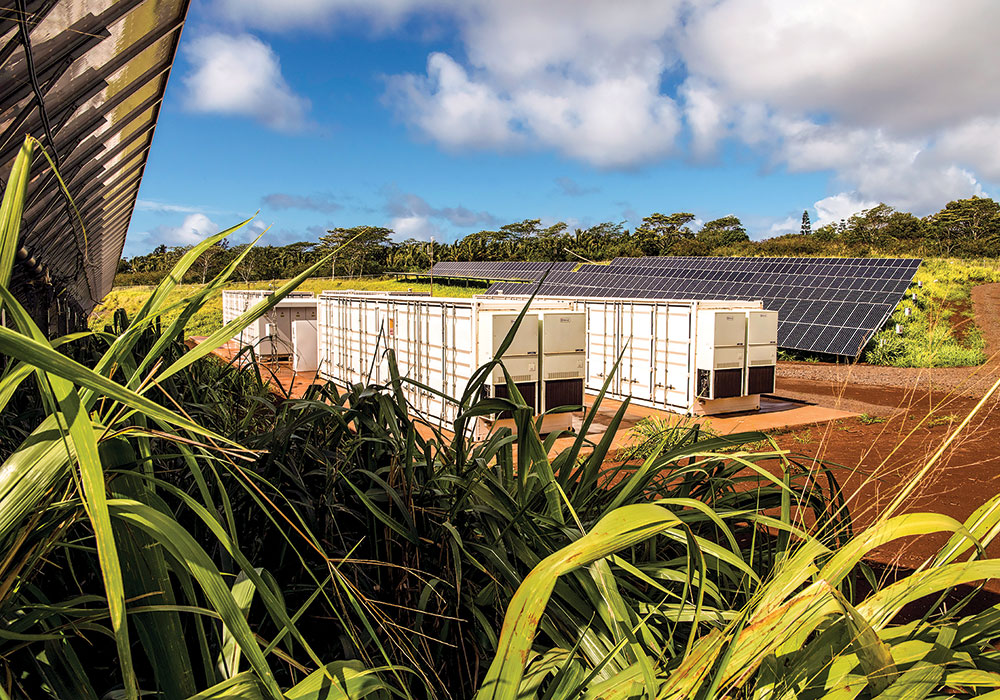
Photo courtesy NREL/DOE.
Identifying clear processes and zoning requirements for solar development saves time and expense for both developers and planning staff. Establishing a clear definition of solar energy systems in their varied forms and scales establishes the foundation for applying appropriate requirements. Including storage in the definition will accommodate the anticipated growth in large-scale solar facilities with on-site battery storage systems (such as this one, in Hawaii) and allow integrated review of storage equipment.
Defining and distinguishing between roof-mounted and ground-mounted installations of various sizes allows subsequent code sections to identify which installations can be permitted by-right and apply directly for a building permit. Such distinctions may be made in a use table.
Allowing small ground-mounted installations as accessory uses and large, primary-use installations through a conditional or special use permit process allows communities to consider each proposed large solar project within its unique context and apply development conditions as appropriate, regardless of the zoning district. An alternative approach is a renewable energy overlay district.
4. Focus on Impacts

Photo by Vencavolrab/iStock/Getty Images Plus.
In attempting to regulate solar or distinguish between principal and accessory uses, communities often mistakenly regulate how much electricity can be generated, who can use the electricity, and who can own photovoltaic equipment. For example, zoning codes may require on-site consumption of photovoltaic electricity generation, which prevents community or shared solar in addition to principal use solar energy generation facilities.
A best practice is to define and apply standards to solar installations based on the area (e.g., square feet or acres) or impact of the installation rather than the capacity (e.g., kilowatts) or how the generated electricity is used to avoid codes from becoming outdated as efficiencies, technologies, and utility business models change over time. Walton County, Georgia, includes language like this in its land development ordinance: "Property used in solar energy development shall be termed a 'solar farm' if the acreage of land utilized in its construction and installation exceeds 5 acres."
5. Avoid Treating PV Like a Building
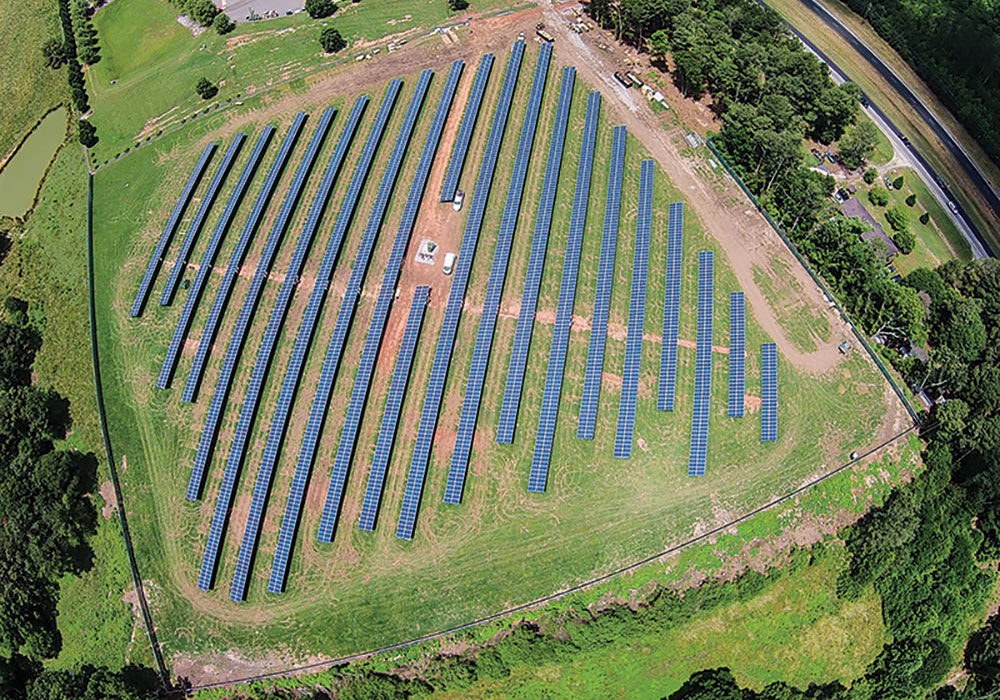
Photo courtesy Walton EMC.
Maximum lot coverage allowances, which limit the percentage of the lot that may be covered by buildings or impervious surfaces — sometimes to as little as 10 percent — can prevent ground-mounted PV development, which frequently makes use of an entire parcel (below in Walton County, Georgia).
While ground-mounted PV equipment pads and racking posts are impervious surfaces, rainwater can flow between panels and support vegetation growth beneath solar arrays, which aids stormwater absorption and erosion control and improves the visual appearance of the property. Exempting vegetated areas from lot coverage and impervious surface calculations can reduce costs and lead to water quality improvements.
Several states, including Maryland and New Jersey, exempt vegetated areas at ground-mounted PV facilities from impervious surface or coverage calculations.
6. Address Community Concerns
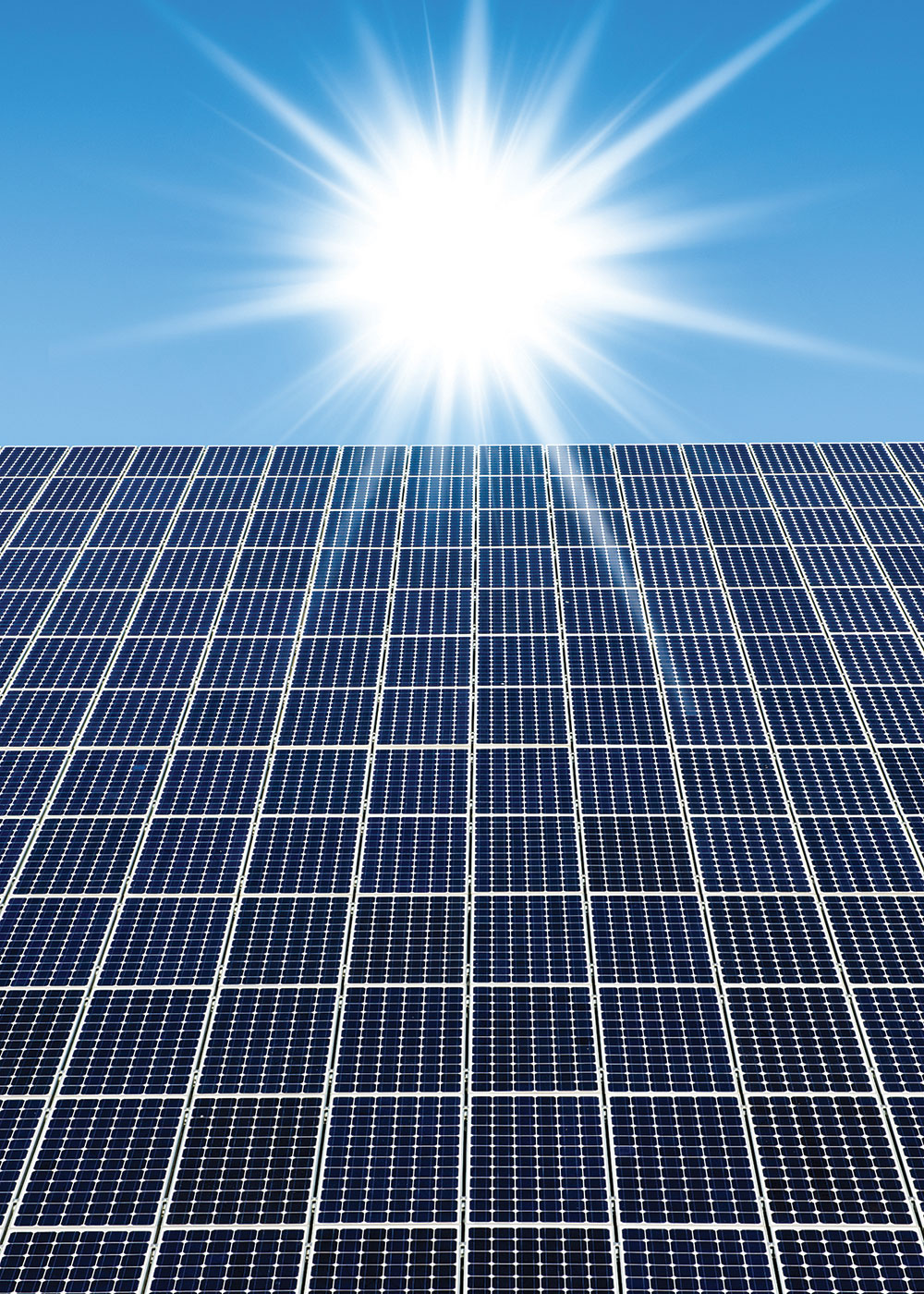
Free Help in Planning for Solar: The SolSmart program, a national designation and technical assistance program funded by the U.S. Department of Energy, recognizes communities for taking steps to streamline solar planning and permitting and open up their local solar market. SolSmart provides free technical assistance to all municipalities, counties, and regional organizations who participate. Photo by Cruphoto/Getty/E+.
Proposed large-scale PV projects often elicit objections based on misperceptions. To be solar ready, planners can distinguish truth from fiction by educating stakeholders about common concerns.
LIGHT REFLECTION. PV modules generally use nonreflective glass and are designed to absorb rather than reflect the light that hits the panels in order to convert solar energy into electricity. PV modules are generally less reflective than windows and water.
NOISE. The noisiest components at a ground-mounted solar installation are the inverters, which generate a low buzzing sound as they convert electricity from the direct current generated by PV modules to alternating current used by the electric grid. Noise generated by large-scale solar installations is generally not audible above ambient noise outside of the facility fence.
PROPERTY VALUES. Though studies are limited in number, none have shown decreased property values adjacent to PV development.
ENVIRONMENTAL AND HEALTH SAFETY. Solar panels do not create air pollution, leach chemicals, or generate harmful electromagnetic fields.
7. Avoid Overly Burdensome Decommissioning Requirements
Large-scale solar ordinances often require a plan for decommissioning at the end of a project's useful life or in the event a facility is not in operation for a year. Land-use entitlements may also require decommissioning bonding or other financial assurance requirements.
Whether the salvage costs of the steel, copper, and aluminum at a facility can be used to cover part or all the decommissioning costs — and how to estimate their future value — is the subject of debate.
While jurisdictions may have concerns about abandonment, the capital investment represented by a large-scale solar facility and the long-term contracts to purchase the electricity generated (generally power purchase agreements) mean that such facilities have significant value and will likely be sold and maintained in the event of the original owner's bankruptcy.
The terms of most large-scale solar facility land leases generally have decommissioning requirements and assurances, further mitigating abandonment risk.
In bonding and other large-scale solar requirements, consider if the regulation is commensurate with other forms of development to avoid a claim of arbitrariness. Is a decommissioning bond required of other structures that have a similar useful life?
Megan Day is a senior energy planner at the National Renewable Energy Laboratory.
Opportunities for Big Benefits from Large-Scale Solar

Bees thrive outside IMS Solar in St. Joseph, Minnesota. Photo by Dennis Schroeder, NREL/DOE.
Solar-ready communities can manage large-scale solar development in ways that capture multiple benefits, from meeting economic and environmental goals to aligning with aesthetic and agricultural needs.
For starters, PV energy generation does not have the associated health and environmental risks that come with fossil fuel electricity generation, such as from coal ash, greenhouse gas emissions, pipeline explosions and leaks, and mercury pollution. Large-scale solar development can also foster economic benefits in the form of jobs and spending primarily during construction, when hundreds of workers may be employed on-site. And it can mean increased property tax income due to capital investment — many millions of dollars — and local power generation without purchasing fuels from outside the community.

Floating PV arrays (such as this one on a water treatment facility in Walden, Colorado) can reduce evaporation and algae growth. Photo by Dennis Schroeder, NREL/DOE.
But the benefits don't stop there. Managed strategically, communities can put solar development to work to meet community objectives beyond economic development and clean energy. Local governments can set large-scale solar performance standards to capture aesthetic, habitat, or environmental conservation; agricultural and farmland preservation; stormwater management and water quality improvement; and even growth management benefits.
For example, an increasing number of states, including Minnesota and Maryland, have statutes that encourage large-scale solar sites to "provide native perennial vegetation and foraging habitat beneficial to gamebirds, songbirds, and pollinators, and reduce storm water runoff and erosion." Flowering ground cover, a landscaped buffer, or a particular style of wall or fencing may be required to provide aesthetic value. Perennial, deep-rooted vegetation at solar facilities can provide improved stormwater management, habitat value, and groundwater protection from nitrogen and other pollutants.
Indeed, PV can be colocated with agricultural land uses like sheep grazing for vegetation control, apiaries for honey production, and even hand-picked high-value crops. Perennially vegetated PV facilities can serve as a form of long-term crop rotation, enhancing the soil and providing revenue for farmers over the 20- to 35-year facility lifespan and enabling the land to revert to agricultural production for future generations.
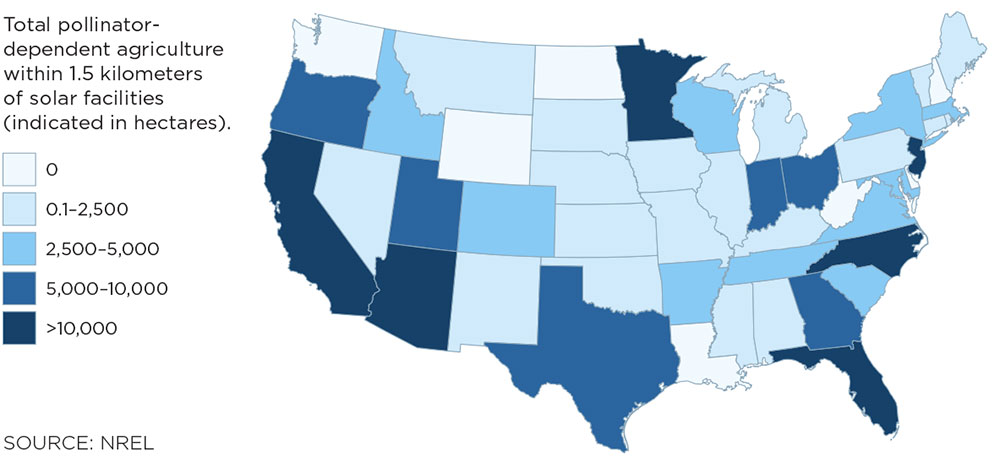
Buzzing Boost to Local Agriculture: Pollinator habitats on solar farms can provide billions of dollars in pollination services. Source: NREL.
Solar development can also provide a long-term, temporary use to delay residential or commercial growth and extension of services in support of growth management goals.
Planting and maintaining pollinator-friendly vegetation at solar energy developments can increase pollination services and insect pest management for nearby agriculture. A study by the National Renewable Energy Laboratory (NREL) and Argonne National Laboratory identified more than 800,000 acres of agricultural land near existing and planned large-scale PV facilities that may benefit. If 10 percent to 50 percent of existing and planned solar facilities were planted with pollinator habitat, they would produce $1.9 to $5.7 billion in pollination services for nearby agriculture.
Ground-mounted solar can also make productive use of landfills, brownfields, airport land, vacant lots, highway rights-of-way, or other underutilized land, which can boost the local economy and increase local tax revenues while potentially redirecting solar development away from farmland, forested land, or other undeveloped sites. For example, the Greenfield Solar Farm, a two-megawatt solar array built on a landfill in Greenfield, Massachusetts, created approximately 50 local construction jobs and saved the town $250,000 in its first year of operation. Jurisdictions can offer incentives such as expedited review, exemption from certain fees or taxes, or financial support to help projects overcome the added costs and risks of development on marginal sites.
Where land values are preventatively high, floating solar (PV arrays mounted on floating pontoons) offers an alternative to ground-mounted arrays. NREL recently estimated the technical generation potential of floating solar on a total of 24,419 man-made water bodies in the contiguous U.S. identified as suitable for floating solar generation. These water bodies include wastewater storage ponds, reservoirs, remediation and tailing ponds, and agricultural irrigation or retention ponds. In aggregate, floating PV could produce almost 10 percent of current national electricity generation, with the added benefit of reducing evaporation and algae growth in their host water bodies.
Case Study: Stearns County
By Brian Ross, AICP
Predictability and transparency are key to solar energy development standards that boost the economy and preserve agriculture.
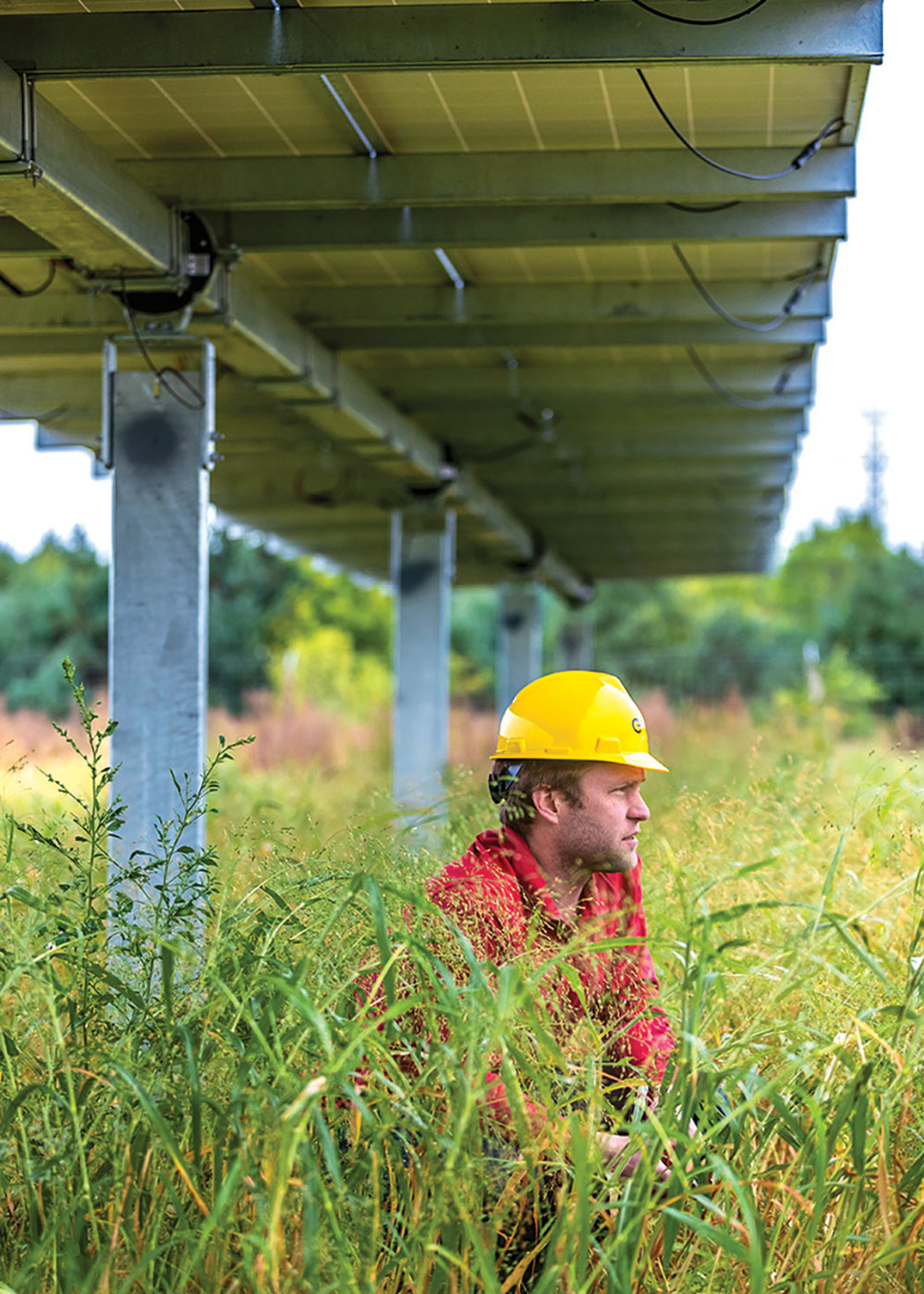
A pollinator test plot underneath the PV array at the Chisago Solar Site in Minnesota. Photo courtesy INSPIRE-Minnesota, NREL/DOE.
Stearns County in central Minnesota is a leading example of how local governments can engage their community to develop solar resources. The Great Plains Institute worked with Stearns County to engage stakeholders and create transparent and predictable solar development regulations, including ensuring pollinator habitat and stormwater benefits.
BACKGROUND: Stearns County (pop. 150,000) is located west of St. Cloud, Minnesota. While the eastern side of the county is quite urban, most of the county is rural, and includes some of the most productive agricultural areas of the Midwest as well as electrical transmission connections to the St. Cloud and Minneapolis/Saint Paul metro regions.
NEED FOR EVALUATION OF SOLAR REGULATION: In its 2008 comprehensive plan update, the county recognized the value of renewable energy development as an economic opportunity. Stearns County developed a solar ordinance in 2010, and recently permitted multiple community solar projects. But since that time, the community solar market evolved, regulatory standards changed, and solar development controversies in nearby counties raised concerns about whether the county's 2010 solar ordinance needed revisiting.
While some nearby counties issued moratoriums on new solar development, Stearns County initiated a solar workgroup to study the issue. Composed of county board and planning commission members, agricultural representatives, solar developers, and landowners, and guided by professional planners, it was charged with proposing new ordinance standards to address the evolving market and community concerns. The group focused on zoning districts, stormwater management, agriculture protection standards, development standards, and more.
GROUNDBREAKING STANDARD: The workgroup recommended that the county's new solar ordinance require all large-scale, ground-mounted solar development meet Minnesota's voluntary "beneficial habitat" standard, legislatively created in 2014. Stearns was the first county to use the state standard, and the first county in the nation to require solar development to be certified as pollinator habitat.
Perennial pollinator habitat not only protects bees and butterflies; it also improves surface water quality through increased infiltration. The county used the beneficial habitat requirement as a compliance pathway for solar development to meet the county's stormwater standards. Large-scale solar installations now support pollinators that enhance Stearns County's agricultural economy and natural systems.
LESSONS LEARNED: The stakeholder-driven process, conducted outside the context of a specific project proposal, allowed measured evaluation and discussion of solar development issues. The process emphasized applying the county's adopted policy goals and existing standards and procedures to the range of circumstances and issues associated with solar development while encouraging economic and environmental benefits of renewable energy.
Stakeholders discovered that existing standards (such as the noxious weed ordinance, screening standards, and extraterritorial jurisdiction process) addressed many of the concerns raised about specific solar development projects, negating the need for additional language in the new solar ordinance.
OUTLOOK: Stearns County continues its commitment to solar development. It is a SolSmart Silver-designated community (see opposite page) and has issued permits for more than 90 megawatts of utility-scale solar and community solar development, one of the highest amounts for a Midwestern county. These projects will generate approximately $3 million in local energy production and property tax revenues over the useful life of the projects.
Brian Ross is a senior program director at the Great Plains Institute.


